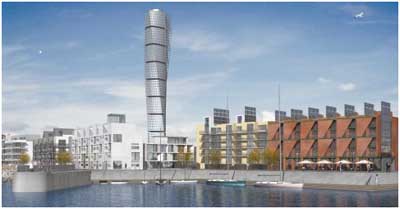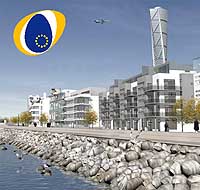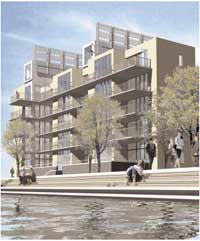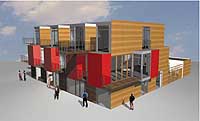Bo01 CITY OF TOMORROW
Västra Hamnen, Malmö, Sweden
Sweden's first international housing exhibition, Bo01, will open on 17 May 2001 in Malmö. The "City of Tomorrow" in the ecologically sustainable information and welfare society will be demonstrated and discussed until 16 September. The aim is to create a debate centered around how we live today and how we will live in the future. Bo01 will show provocatively imaginative visions of future living, where high demands on aesthetics, ecology and high technology are combined with placing man in the centre. We are going to do this is two different locations:
The Housing area
The residential area, a newly built permanent city district with mixed buildings, encompassing both commercial and social services together with about 500 housing units. Bo01 demonstrates how intelligently utilised information technology, dignified welfare solutions and pleasurable, sensual beauty can make the sustainable city so attractive that it will be chosen in our time.The Exhibitions
The Urban Form
A temporary exhibition area where the theme is discussed with theemphasis on the visionary. Ideas and visions of future living areas which cannot be fully realised today are here in the form of exhibits— as a contribution to further debate. This is northern Europe's largest exhibition investment in the year 2001.
On a magnificently situated point of land in resund, a new urban center is being constructed for living, education and work, with the aim of showing that high-class architecture provides better conditions for the long-term sustainability of buildings and cities. The first stage will be completed in May 2001 and will be included in the European Bo01 City of Tomorrow home exhibition. Bo01 maintains that the speedy conversion of society to long-term sustainability will only be possible when the sustainable alternative is perceived as more attractive — the sustainable city and sustainable way of life must therefore prove itself to be at least equally as convenient, financially advantageous, comfortable, pleasant, exciting and beautiful as today´s non-sustainable ones. The currently quantifiable requirements for ecological sustainability (e.g. energy saving — the district will actually be self-sufficient with energy) are thus necessary, but not sufficient – only when intellectual, emotional, and social requirements are provided for can the sustainable society be achieved. Sustainability presupposes genuine consideration and intellectual commitment.
The site The location in the city is unique — Västra Hamnen, a former industrial estate by the ocean, within walking distance of both the city center and the beach. The district consists of landfill, and is currently flat and desolate, apart from a narrow park along the seafront. There are already some industrial enterprises, offices, and university buildings by VästraHamnen, such as the enormous workshop building that currently houses the Malmö trade fair. The permanent part of Bo01 makes up the first stage of Västra Hamnen´s conversion into a complete, new district for living, work and study. We want to demonstrate there that this industrial wasteland can be transformed into the center of the world. Urban form


The plan has been sculpted by the grandeur of the site (the ocean, the expanse of sky, the horizon, the sunset), by very strong exposure to the wind from the west, and by the broad-meshed grid of boulevards in the district. This ensures orderliness and empathy on a grand scale and at the same time, gives space to discover a teeming, less tangible world on the inside of the large squares. The plan has also been shaped by our ambitions: — to offer an urban structure that is sufficiently robust, — to meet the demands of an uncertain future (the network structure of block city and clear borders between the public and private spaces), — to provide the conditions for the essence of the city, the meeting between different people and cultures, — to come about gradually (the small-scale property division of the plan, its range of different residential environments), — to let cars get through, but on the terms of the pedestrians, — to provide the conditions of a city environment which, over and above empathy and comprehensibility, also offer a wealth of information, mystery, surprises, and many unique and promising urban spaces; a dramatic tension between the grand and the intimate, — to offer a wealth of all forms of vegetation, from the individual garden, to the sheltered, thickly wooded public canal park through the interior of the area. That is how the plan took shape. The grid has been distorted by the wind, among other things, like a fishnet hung out to dry. And as a result it has actually become more rational, more valuable to build, live and stroll around in. Thus the urban form is not from the "Middle Ages", but is of today. The inspiration comes from antiquity, the Middle Ages, the Renaissance, the Baroque period, the 20th Century, and the scale of the interior of the area takes its precedents from typical northern European cities — low, tight, intimate, incredibly efficient in its use of area. The total development rights are for approx. 180,000 m2.
Klas Tham
Principal Exhibition Architect Bo01
E-mail: klas.tham@bo01.com Bo01 — the Ecological City From Polluted Industrial Land to a Leading Ecological Area
Four fifths of the world's population will be living in cities within a few decades. Urbanisation generates economic development and well being, but also leads to problems with water and sewage, traffic, poor energy systems and overconsumption of resources. Solving the cities' environmental problems is therefore the key to a sustainable future. The aim is for the district to be an internationally leading example of environmental adaptation of a densely built urban environment. It will also be a driving force in Malmö's development towards environmental sustainability.

100 % Locally Renewable Energy
The new city district will exclusively be supplied by renewable sources of energy. The energy used in the Western Harbour will be generated in or near the area. A large proportion of the heating needs will be extracted from sea water and groundwater and will be complimented with solar collectors. Electricity will be generated by wind power and photovoltaic cells. Bio gas will be produced from the area's waste and will be used to heat homes and power vehicles. An effective energy usage is essential in order to reach the target of entirely locally produced renewable energy. The buildings in the district are designed to minimize energy demands for heating and electrical equipment that is installed should be highly energy efficient.Eco-Cycle
The area is attached to the existing sewage system in Malmö, which will be improved with a plant to extract nutrients and heavy metals from the sludge. The nutrients can then be returned to agriculture and the metals used in the treatment process can be reused. A large amount of the organic waste produced in the area will be transformed to biogas in a new bio gas digesters. The household waste that is not separated for recycling goes into the vacuum refuse chutes where the waste is separated into organic waste and other waste. The organic waste is taken to the bio gas plant for digestion into bio gas which is then returned to the housing area. The remaining waste will be incinerated to generate district heat. Recyclable packaging materials will be collected at special points close to the houses.Traffic
The area is planned to minimize future transport needs and car dependency. Cycle traffic is the most important element in the area's transport system. The footpath and cycleway network will be of a standard to make it an attractive alternative for short journeys. Cyclists in the area will always be prioritised ahead of cars. The public transport system will be attractive and well developed from the outset in order to attract many users and become the natural choice for residents in the area. A major programme for vehicles powered by environmentally friendly fuels is planned. Public transport will run on environmentally fuels, the area's car pool will have a number of electric or gas powered vehicles and vehicles used for the maintenance of the area will also be electrically powered.Ecological Building
Environmental thinking is ever present in the construction of the district's properties. Substances listed in the Swedish Chemicals Inspectorate's list of hazardous materials will not be used in the building process. The buildings will be built so that inhabitants and users can utilise them in an environmentally friendly and resource efficient way. Building materials should be reusable when the buildings are demolished.Biodiversity
The district is being built with the aim of containing a diverse range of natural life. A number of habitats are being created for many different plant and animal species. Roofs and walls will be covered with plants in order to increase the green space. Rainwater and seawater will be used in public spaces to support a broad range of species. A district ecologist will be employed in the Western Harbour area.Local Investment Programme for Ecological Adaptation
Hanna Roberts
Bo01/Western harbour is part of Malmö's Local Investment Programme for ecological development (LIP) which includes a number of projects to accelerate the development of an environmentally sustainable Malmö.
Head of Environment
E-mail: hanna.roberts@bo01.com
The green Bo01BO01 CITY OF TOMORROW
Sweden´s first international housing exhibition, Bo01, will open on 17 May 2001. The "City of Tomorrow" in the ecologically sustainable information and welfare society will be demonstrated and discussed until 16 September. The aim is to create a debate centered around how we live today and how we will live in the future. Bo01 will show provocatively imaginative visions of future living, where high demands on aesthetics, ecology and high technology are combined with placing man in the centre. We are going to do this is two different locations:The permanent Settlement (A)
The residential area, a newly built permanent city district with mixed buildings, encompassing both commercial and social services together with about 500 housing units. Bo01 demonstrates how intelligently utilised information technology, dignified welfare solutions and pleasurable, sensual beauty can make the sustainable city so attractive that it will be chosen in our time.The temporary exhibition (B)
A temporary exhibition area where the theme is discussed with the emphasis on the visionary. Ideas and visions of future living areas which cannot be fully realised today are here in the form of exhibits —as a contribution to further debate. This is northern Europe's largest exhibition investment in the year 2001. Our ambition is that both the above parts should together form a whole, an attraction of international class. Architects, artists, designers and technicians at national and international levels are helping us to realise this ambition. Bo01 is expected to attract at least one million visitors. Bo01 is supported by the Swedish Gouvernment and the European Commission.
We know, from statistics of earlier national housing exhibitions, that there are two main visitor attractions: garden and interior design. There is nothing intrinsically surprising about the great interest aroused by gardens, but previous housing exhibitions have never put the garden very high on their list of priorities or done very much to market it. With few exceptions, courtyards, parks, streets and piazzas have barely been completed. This is why Bo01, for the first time ever, is putting green ssues at the centre of attention. We are adopting a holistic approach to the subject, both large and small scale and in both the permanent and temporary parts of the exhibition. Our means to this end are as follows:
• Visitors and residents will experience homes and the external environment as a single unit in the permanent part of the exhibition,the Settlement. Here Bo01 will instance what can be achieved in a newly constructed urban environment with ecological, aesthetic and functional inflections. Parks, waterfront promenades, streets and piazzas and exciting courtyards will be created with a very high level of aspiration. The public environment at Bo01 is intended to attract people from all over Malmö.
• We are also putting green in focus by making the entire frame of the temporary exhibition area consist of a large, newly planted Willow wood. This Willow wood, the first thing which the visitor encounters on arrival at Bo01, is intended as an appetizer for the temporary green projects, all of which interact with the wood and, hopefully, will arouse widespread attention. The main Bo01 entrance is located in the temporary exhibition area, and this is devoted to a discussion of the Bo01 theme, with special emphasis on the visionary. Garden, park and nature are an important part of our housing conditions, and so in this part of the exhibition we want to present green projects which can't rigger discussions concerning the importance of the garden to peopleof tomorrow.Agneta Persson
Director Exhibition Planning
responsible for the green concepts at Bo01THE HOUSES
The buildings of Bo01 City of Tomorrow are the first part in the process of transforming the former industrial area to a brand new living urban district. The housing exhibition gives promises for tomorrows way of living with man in focus.
Some of Europe's most promising and interesting architects have created the new environment, such as Santiago Calatrava, Zurich, Gert Wingård, Gothenburg, Kai Wartiainen, Stockholm, Ralph Erskine, Stockholm and Bertil Öhrström, Malmö, in cooperation with Moore Ruble Yudell, USA. Bo01 also highlights some young swedish and danish architects.
The housing area consists of 500 dwellings in a very varied design. From one and a half storys to the height of six storeys. Higher blocks towards the keyside and lower in the area in between. Just to make the inner part of the housing area more comfortable and cozy and sheltered from the strong winds from the sea.


HOME EXHIBITIONS
Bo01 also presents the largest housing exhibition of all time with about 50 specially furnished and designed dwellings in the newly erected houses. The great number of inspiring dwellings are created by internationally well known designers.
For further information contact:
Bo01 City of Tomorrow Box 453 SE-201 24 Malmö, Sweden
Phone: +46 40 668 09 00
Fax: +46 40 668 09 10
E-mail: bo01@bo01.com
Key stakeholders in Bo01 are the Swedish government, the City of Malmö, Sydkraft, Telia, HSB and SBAB. The project is also supported by the European Commission.
Return to:
The New City Markers
Return to:
Proposal
Return to:
Recent Projects
Return to:
MAIN


